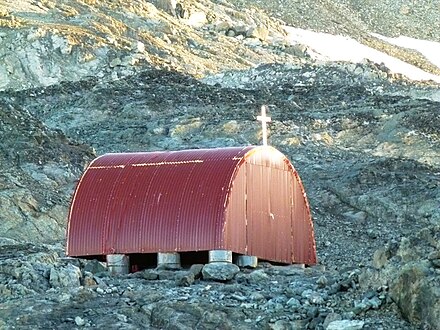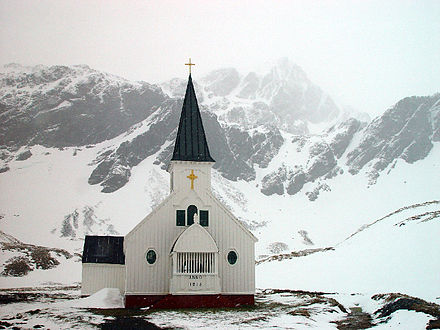Churches in Antarctica
Churches in Antarctica
Christianity has found its way onto all seven continents of the world. It reached Antarctica two centuries ago and there are now eight churches on or near the continent, with others further out. They are often associated with research stations, and are of cultural and architectural interest.
This page doesn't describe isolated crosses and memorials, which stand in many places where people lost their lives on this harsh continent.
Understand

Penguins, whalers, polar researchers and churches all seek a rock to found upon. Matthew 7:24–27 likewise relates the parable of the houses built upon rock or upon sand, in the Sermon on the Mount. The parable didn't mention ice but this shifts and fissures and grinds, eventually destroying anything built upon it.
Beseechings of their god were probably the last cries of the 644-strong crew of San Telmo, the first deaths in Antarctica. In 1819 that ship was disabled and disappeared into the storm at 62°S and its wreckage was later found on Livingston Island near the Peninsula. So religion, especially organised religion with its temples, community rites and burials, arrived here with ships from the 19th century. These were the ships of Europe and North America so they brought Christianity, both in western forms and as eastern Orthodox. On many vessels, especially warships, religious observance was part of daily discipline. Others were laxer, and the whalers were cause for despair by their priests, yet cleaving to their faith in times of crisis and funeral rites. Other cultures have been great sea-farers and explorers but weren't part of this era, so their religion wasn't imported in an organised way. Services of those other faiths are sometimes held, for instance at McMurdo. However this page only describes churches since mosques, synagogues and pagodas have not yet been built in Antarctica.
Churches
For opening hours and other practicalities see the relevant pages.
Churches south of 60°S lack graveyards as the ground is too hard. The deceased nowadays are repatriated; in bygone days they had sea burials, while those lost on expeditions had to be left to be buried by snow where they lay.
Peninsula and South Shetland Islands
This region is the closest to South America so it was the first to be explored and settled, and has the most churches, often visited by cruises.
- Chapel of St Mary Queen of Peace 📍 is in Villa Las Estrellas on King George in the South Shetland Islands. The Villa is an attempt by Chile to establish a civilian town in Antarctica, though in 2018 the school closed and much of the population left. The church is simply a metal shipping container.
- Holy Trinity Church is 500 m west of St Mary's in Villa Las Estrellas. It's Russian Orthodox and the most attractive on the continent, a 15 m-high traditional wooden church of Siberian pine. It opened in 2004 and is staffed year-round by monks from Trinity Lavra of St Sergius in Sergiev Posad north of Moscow. In 2007 Antarctica's first church wedding was held here.
- St Ivan Rilski Chapel 📍 is near St Kliment Ohridski Base on Livingston Island. This is the next large island west from King George so cruise ships often visit, then turn south for the spectacular scenery of Deception Island. The church is Bulgarian Eastern Orthodox Church, named after St Ivan Rilski patron saint of the Bulgarians, and the southernmost Eastern Orthodox building of worship in the world. It was established in 2003 but replaced on a more accessible spot in 2011.
- Chapel of St Francis of Assisi 📍 is at Argentina's Esperanza Base on the Antarctic Peninsula. Argentina sought to establish a civilian town here similar to Chile's Villa Las Estrellas. St Francis was the first Roman Catholic chapel on the continent and has seen a few Antarctic firsts: the first baptism (of Emilio Palma born at the base), the first communion, the first religious wedding, and so on. It's regarded as the senior RC church of the eight in Antarctica.
- Chapel of Santisima Virgen de Lujan 📍 is a steel prefab with a bell and cross at Marambio, Argentina's base at Seymour Island near the tip of the Antarctic Peninsula. There's a large airfield but cruises seldom visit, as this is the icy east side of the Peninsula.
- St Volodymyr Chapel is Ukrainian Orthodox and serves Ukraine's Vernadsky Base on Galindez Island along the Antarctic Peninsula. It's a simple wooden hut with a richly decorated interior. This is as far south as cruises usually venture.
Other Antarctic churches
- Chapel of the Snows 📍 is at McMurdo Station on Ross Island. It's non-denominational and also hosts services for other faiths. It first opened in 1956 but burned down, and the present building is from 1989.
- Chapel of Our Lady of the Snows is at Belgrano II Base in West Antarctica. It's carved out of the ice.
Subantarctic churches

The Subantarctic is usually defined as the region between 45° and 60°S south, but the climate has other ideas.
These churches may have historic graveyards, since it's possible to conduct burials in unfrozen terrain, and they have more of a population in need of Last Offices.
- Norwegian Church 📍 is at Grytviken on South Georgia Island. It was completed in 1913 as the Norwegian Lutheran Church, whose pastor regretted that “religious life does not wax strong amongst the whalers and left much to be desired”. It was variously a library, cinema, food store, and concert hall, but cleared for Ernest Shackleton's coffin to lie in state after his death here in 1922. It was renovated 1996-98 and in 2013 became Anglican (Church of England). It remains active and occasionally holds services.
- Notre-Dame-du-Vent 📍 is in Port-aux-Français, Kerguelen, part of the French Southern and Antarctic Lands. It was built in concrete in the 1950s and is the southernmost French place of worship. It's on about the same latitude south as Rouen cathedral is north.
- Chapelle Notre-Dame-des-Oiseaux 📍 is a tiny Roman Catholic chapel on Île de la Possession in the Crozet Islands, only the size of a small room in a house.
- Christ Church Cathedral 📍 is the world's most southerly cathedral. It's in Stanley in the Falkland Islands, so although it's about 52°S and some 300 km further south than Kerguelen, the climate is much milder and the Falklands are therefore not thought of as "Subantarctic".
- Tierra del Fuego is around 53°S yet likewise a milder, well-developed area, both in its Argentine portion and its more thinly populated Chilean portion. So you'll find churches and all sorts of amenities if you pass through Ushuaia to join a polar cruise. All this reflects the "Antarctic Convergence", the landless but distinct boundary between the South Atlantic and the much colder Antarctic Ocean.
See also
- Antarctica and related pages describes the places where these churches are sited.
- Christianity is one of the world's main religions. See Religion and spirituality for pointers to the others.